A Review of Piezoelectric Footwear Energy Harvesters: Principles, Methods, and Applications
Abstract
:1. Introduction
2. Fundamentals of Piezoelectric Properties for Footwear Energy Harvesters
3. Force and Dynamic Energy Distributions on Foot Print
3.1. Foot Pressure
3.2. Ground Reaction Forces (GRF)
3.3. Acceleration
4. Energy Flow Chart
5. Structures and Configurations of the Piezoelectric Footwear Power Generators
5.1. Flat Plate
5.2. Curved Structures
5.3. Cantilever
5.4. Flextensional
6. Applications
6.1. For Military Missions
6.2. For Health Care and Monitoring
6.3. For Other Applications
6.3.1. Night Safety
6.3.2. Frostbite Protection
6.3.3. Hiking
6.3.4. Extreme Environment
7. Summary
Author Contributions
Funding
Institutional Review Board Statement
Informed Consent Statement
Data Availability Statement
Conflicts of Interest
References
- Beeby, S.P.; Cao, Z.; Almussallam, A. 11-Kinetic, Thermoelectric and Solar Energy Harvesting Technologies for Smart Textiles. In Multidisciplinary Know-How for Smart-Textiles Developers; Kirstein, T., Ed.; Woodhead Publishing Series in Textiles; Woodhead Publishing: Cambridge, UK, 2013; pp. 306–328. ISBN 978-0-85709-342-4. [Google Scholar]
- Turkmen, A.C.; Celik, C. Energy Harvesting with the Piezoelectric Material Integrated Shoe. Energy 2018, 150, 556–564. [Google Scholar] [CrossRef]
- Rehmani, M.H.; Reisslein, M.; Rachedi, A.; Erol-Kantarci, M.; Radenkovic, M. Integrating Renewable Energy Resources Into the Smart Grid: Recent Developments in Information and Communication Technologies. IEEE Trans. Ind. Inform. 2018, 14, 2814–2825. [Google Scholar] [CrossRef]
- Nechibvute, A.; Chawanda, A.; Luhanga, P. Piezoelectric Energy Harvesting Devices: An Alternative Energy Source for Wireless Sensors. Smart Mater. Res. 2012, 2012, 853481. [Google Scholar] [CrossRef] [Green Version]
- Maamer, B.; Boughamoura, A.; Fath El-Bab, A.M.R.; Francis, L.A.; Tounsi, F. A Review on Design Improvements and Techniques for Mechanical Energy Harvesting Using Piezoelectric and Electromagnetic Schemes. Energy Convers. Manag. 2019, 199, 111973. [Google Scholar] [CrossRef]
- Xu, T.-B.; Siochi, E.J.; Kang, J.H.; Zuo, L.; Zhou, W.; Tang, X.; Jiang, X. Energy Harvesting Using a PZT Ceramic Multilayer Stack. Smart Mater. Struct. 2013, 22, 065015. [Google Scholar] [CrossRef] [Green Version]
- Zou, H.-X.; Zhao, L.-C.; Gao, Q.-H.; Zuo, L.; Liu, F.-R.; Tan, T.; Wei, K.-X.; Zhang, W.-M. Mechanical Modulations for Enhancing Energy Harvesting: Principles, Methods and Applications. Appl. Energy 2019, 255, 113871. [Google Scholar] [CrossRef]
- Yang, Z.; Zhou, S.; Zu, J.; Inman, D. High-Performance Piezoelectric Energy Harvesters and Their Applications. Joule 2018, 2, 642–697. [Google Scholar] [CrossRef] [Green Version]
- Liu, M.; Qian, F.; Mi, J.; Zuo, L. Biomechanical Energy Harvesting for Wearable and Mobile Devices: State-of-the-Art and Future Directions. Appl. Energy 2022, 321, 119379. [Google Scholar] [CrossRef]
- Chamanyeta, H.N.; El-Bab, A.M.; Ikua, B.W.; Murimi, E. Development of a Varying Multi-Cantilever Beam Frequency up Conversion Energy Harvester. Energy Convers. Manag. X 2022, 16, 100290. [Google Scholar] [CrossRef]
- The How and Why of Energy Harvesting for Low-Power Applications—Technical Articles. Available online: https://www.allaboutcircuits.com/technical-articles/how-why-of-energy-harvesting-for-low-power-applications/ (accessed on 4 November 2022).
- Covaci, C.; Gontean, A. Piezoelectric Energy Harvesting Solutions: A Review. Sensors 2020, 20, 3512. [Google Scholar] [CrossRef]
- Moro, L.; Benasciutti, D. Harvested Power and Sensitivity Analysis of Vibrating Shoe-Mounted Piezoelectric Cantilevers. Smart Mater. Struct. 2010, 19, 115011. [Google Scholar] [CrossRef]
- Qian, F.; Xu, T.-B.; Zuo, L. Design, Optimization, Modeling and Testing of a Piezoelectric Footwear Energy Harvester. Energy Convers. Manag. 2018, 171, 1352–1364. [Google Scholar] [CrossRef]
- Xu, T.-B.; Siochi, E.J.; Zuo, L.; Jiang, X.; Kang, J.H. Multistage Force Amplification of Piezoelectric Stacks. U.S. Patent 9,048,759, 2 June 2015. [Google Scholar]
- Leinonen, M.; Palosaari, J.; Juuti, J.; Jantunen, H. Combined Electrical and Electromechanical Simulations of a Piezoelectric Cymbal Harvester for Energy Harvesting from Walking. J. Intell. Mater. Syst. Struct. 2014, 25, 391–400. [Google Scholar] [CrossRef]
- Jeong, S.Y.; Hwang, W.S.; Cho, J.Y.; Jeong, J.C.; Ahn, J.H.; Kim, K.B.; Hong, S.D.; Song, G.J.; Jeon, D.H.; Sung, T.H. Piezoelectric Device Operating as Sensor and Harvester to Drive Switching Circuit in LED Shoes. Energy 2019, 177, 87–93. [Google Scholar] [CrossRef]
- Asano, S.; Nishimura, S.; Ikeda, Y.; Nishimura, S.; Ikeda, Y.; Morita, T.; Hosaka, H. Energy Harvester for Safety Shoes Using Parallel Piezoelectric Links. Sens. Actuators A Phys. 2020, 309, 112000. [Google Scholar] [CrossRef]
- Ahmad, N.; Rafique, M.T.; Jamshaid, R. Design of Piezoelectricity Harvester Using Footwear. In Proceedings of the 2019 IEEE 6th International Conference on Engineering Technologies and Applied Sciences (ICETAS), Kuala Lumpur, Malaysia, 20–21 December 2019; pp. 1–5. [Google Scholar]
- Zeng, P.; Chen, H.; Yang, Z.; Khaligh, A. Unconventional Wearable Energy Harvesting from Human Horizontal Foot Motion. In Proceedings of the 2011 Twenty-Sixth Annual IEEE Applied Power Electronics Conference and Exposition (APEC), Fort Worth, TX, USA, 6–11 March 2011; pp. 258–264. [Google Scholar]
- Liu, Y.; Fu, W.; Li, W.; Sun, M. Design and Analysis of a Shoe-Embeded Power Harvester Based on Magnetic Gear. IEEE Trans. Magn. 2016, 52, 9100404. [Google Scholar] [CrossRef]
- Zhao, X.; Cai, J.; Guo, Y.; Li, C.; Wang, J.; Zheng, H. Modeling and Experimental Investigation of an AA-Sized Electromagnetic Generator for Harvesting Energy from Human Motion. Smart Mater. Struct. 2018, 27, 085008. [Google Scholar] [CrossRef]
- Zeng, P.; Khaligh, A. A Permanent-Magnet Linear Motion Driven Kinetic Energy Harvester. IEEE Trans. Ind. Electron. 2013, 60, 5737–5746. [Google Scholar] [CrossRef]
- Deng, F.; Cai, Y.; Fan, X.; Gui, P.; Chen, J. Pressure-Type Generator for Harvesting Mechanical Energy from Human Gait. Energy 2019, 171, 785–794. [Google Scholar] [CrossRef]
- Bai, P.; Zhu, G.; Lin, Z.-H.; Jing, Q.; Chen, J.; Zhang, G.; Ma, J.; Wang, Z.L. Integrated Multilayered Triboelectric Nanogenerator for Harvesting Biomechanical Energy from Human Motions. ACS Nano 2013, 7, 3713–3719. [Google Scholar] [CrossRef]
- Hou, T.-C.; Yang, Y.; Zhang, H.; Chen, J.; Chen, L.-J.; Lin Wang, Z. Triboelectric Nanogenerator Built inside Shoe Insole for Harvesting Walking Energy. Nano Energy 2013, 2, 856–862. [Google Scholar] [CrossRef]
- Zhou, Z.; Weng, L.; Tat, T.; Libanori, A.; Lin, Z.; Ge, L.; Yang, J.; Chen, J. Smart Insole for Robust Wearable Biomechanical Energy Harvesting in Harsh Environments. ACS Nano 2020, 14, 14126–14133. [Google Scholar] [CrossRef]
- Xing, F.; Jie, Y.; Cao, X.; Li, T.; Wang, N. Natural Triboelectric Nanogenerator Based on Soles for Harvesting Low-Frequency Walking Energy. Nano Energy 2017, 42, 138–142. [Google Scholar] [CrossRef]
- Zhu, G.; Bai, P.; Chen, J.; Lin Wang, Z. Power-Generating Shoe Insole Based on Triboelectric Nanogenerators for Self-Powered Consumer Electronics. Nano Energy 2013, 2, 688–692. [Google Scholar] [CrossRef]
- Rodrigues, C.; Gomes, A.; Ghosh, A.; Pereira, A.; Ventura, J. Power-Generating Footwear Based on a Triboelectric-Electromagnetic-Piezoelectric Hybrid Nanogenerator. Nano Energy 2019, 62, 660–666. [Google Scholar] [CrossRef]
- Li, Z.; Saadatnia, Z.; Yang, Z.; Naguib, H. A Hybrid Piezoelectric-Triboelectric Generator for Low-Frequency and Broad-Bandwidth Energy Harvesting. Energy Convers. Manag. 2018, 174, 188–197. [Google Scholar] [CrossRef]
- Iqbal, M.; Khan, F.U.; Mehdi, M.; Cheok, Q.; Abas, E.; Nauman, M.M. Power Harvesting Footwear Based on Piezo-Electromagnetic Hybrid Generator for Sustainable Wearable Microelectronics. J. King Saud Univ. Eng. Sci. 2022, 34, 329–338. [Google Scholar] [CrossRef]
- Iqbal, M.; Nauman, M.M.; Khan, F.U.; Abas, P.E.; Cheok, Q.; Iqbal, A.; Aissa, B. Multimodal Hybrid Piezoelectric-Electromagnetic Insole Energy Harvester Using PVDF Generators. Electronics 2020, 9, 635. [Google Scholar] [CrossRef] [Green Version]
- Safaei, M.; Sodano, H.A.; Anton, S.R. A Review of Energy Harvesting Using Piezoelectric Materials: State-of-the-Art a Decade Later (2008–2018). Smart Mater. Struct. 2019, 28, 113001. [Google Scholar] [CrossRef]
- Dicken, J.; Mitcheson, P.D.; Stoianov, I.; Yeatman, E.M. Power-Extraction Circuits for Piezoelectric Energy Harvesters in Miniature and Low-Power Applications. IEEE Trans. Power Electron. 2012, 27, 4514–4529. [Google Scholar] [CrossRef]
- Sekhar, M.C.; Veena, E.; Kumar, N.S.; Naidu, K.C.B.; Mallikarjuna, A.; Basha, D.B. A Review on Piezoelectric Materials and Their Applications. Cryst. Res. Technol. 2023, 58, 2200130. [Google Scholar] [CrossRef]
- Wang, H.; Jasim, A.; Chen, X. Energy Harvesting Technologies in Roadway and Bridge for Different Applications—A Comprehensive Review. Appl. Energy 2018, 212, 1083–1094. [Google Scholar] [CrossRef]
- Liu, H.; Fu, H.; Sun, L.; Lee, C.; Yeatman, E.M. Hybrid Energy Harvesting Technology: From Materials, Structural Design, System Integration to Applications. Renew. Sustain. Energy Rev. 2021, 137, 110473. [Google Scholar] [CrossRef]
- Wang, N.; Liu, Y.; Ye, E.; Li, Z.; Wang, D. Control Methods and Applications of Interface Contact Electrification of Triboelectric Nanogenerators: A Review. Mater. Res. Lett. 2022, 10, 97–123. [Google Scholar] [CrossRef]
- Qian, F.; Xu, T.B.; Zuo, L. Material Equivalence, Modeling and Experimental Validation of a Piezoelectric Boot Energy Harvester. Smart Mater. Struct. 2019, 28, 075018. [Google Scholar] [CrossRef]
- Starner, T.E.; Paradiso, J. Human-Generated Power for Mobile Electronics. In Low Power Electronics Design; Piguet, C., Ed.; CRC Press: New York, NY, USA, 2004; pp. 45-1–45-35. ISBN 13 978-1-4200-3955-9. [Google Scholar]
- Xu, T.-B. Energy Harvesting Using Piezoelectric Materials in Aerospace Structures. In Structural Health Monitoring (SHM) in Aerospace Structures; Elsevier: Amsterdam, The Netherlands, 2016; pp. 175–212. [Google Scholar]
- PI Ceramic GmbH, Fundamentals of Piezo Technology. Available online: https://www.piceramic.com/en/expertise/piezo-technology/fundamentals/ (accessed on 6 November 2022).
- Berlincourt, D. Piezoelectric Crystals and Ceramics. In Ultrasonic Transducer Materials; Springer: Berlin/Heidelberg, Germany, 1971; pp. 63–124. [Google Scholar]
- Erturk, A.; Inman, D.J. 1.4 Summary of the Theory of Linear Piezoelectricity. In Piezoelectric Energy Harvesting, 1st ed.; John Wiley & Sons: Hoboken, NJ, USA, 2011; pp. 9–12. [Google Scholar]
- Piezoelectricity & Piezo Applications. Available online: https://www.americanpiezo.com/knowledge-center/piezo-theory/piezoelectricity.html (accessed on 6 November 2022).
- Priya, S.; Song, H.-C.; Zhou, Y.; Varghese, R.; Chopra, A.; Kim, S.-G.; Kanno, I.; Wu, L.; Ha, D.S.; Ryu, J.; et al. A Review on Piezoelectric Energy Harvesting: Materials, Methods, and Circuits. Energy Harvest. Syst. 2017, 4, 3–39. [Google Scholar] [CrossRef]
- ScienceDirect Topics. Single Crystal Material—An Overview. Available online: https://www.sciencedirect.com/topics/computer-science/single-crystal-material (accessed on 7 November 2022).
- Chen, Z.; Song, L.; Zhao, H.; Zhang, Y.; Cao, W. Temperature- and Electric Field-Dependence of Polarization Hysteresis for a [001] c Poled PMN-PT Single Crystal. J. Asian Ceram. Soc. 2022, 10, 203–214. [Google Scholar] [CrossRef]
- Priya, S. Advances in Energy Harvesting Using Low Profile Piezoelectric Transducers. J. Electroceramics 2007, 19, 167–184. [Google Scholar] [CrossRef]
- Acosta, M.; Novak, N.; Rojas, V.; Patel, S.; Vaish, R.; Koruza, J.; Rossetti, G.A., Jr.; Rödel, J.J. BaTiO3-Based Piezoelectrics: Fundamentals, Current Status, and Perspectives. Appl. Phys. Rev. 2017, 4, 041305. [Google Scholar] [CrossRef] [Green Version]
- Ueberschlag, P. PVDF Piezoelectric Polymer. Sens. Rev. 2001, 21, 118–126. [Google Scholar] [CrossRef]
- Xin, Y.; Tian, H.; Guo, C.; Li, X.; Sun, H.; Wang, P.; Lin, J.; Wang, S.; Wang, C. PVDF Tactile Sensors for Detecting Contact Force and Slip: A Review. Ferroelectrics 2016, 504, 31–45. [Google Scholar] [CrossRef]
- Xin, Y.; Guo, C.; Qi, X.; Tian, H.; Li, X.; Dai, Q.; Wang, S.; Wang, C. Wearable and Unconstrained Systems Based on PVDF Sensors in Physiological Signals Monitoring: A Brief Review. Ferroelectrics 2016, 500, 291–300. [Google Scholar] [CrossRef]
- Klinge, U.; Klosterhalfen, B.; Öttinger, A.P.; Junge, K.; Schumpelick, V. PVDF as a New Polymer for the Construction of Surgical Meshes. Biomaterials 2002, 23, 3487–3493. [Google Scholar] [CrossRef]
- PIEZO.COM. Materials Technical Data (Typical Values). Available online: https://support.piezo.com/article/62-material-properties (accessed on 31 May 2023).
- CTS Corporation. Piezoelectric PMN-PT Single Crystal Products. Available online: https://www.ctscorp.com/wp-content/uploads/2016.12.15-Single-Crystal-Brochure.pdf (accessed on 31 May 2023).
- Uchino, K. The Development of Piezoelectric Materials and the New Perspective. In Advanced Piezoelectric Materials; Elsevier: Amsterdam, The Netherlands, 2017; pp. 1–92. ISBN 978-0-08-102135-4. [Google Scholar]
- Kobiakov, I.B. Elastic, Piezoelectric and Dielectric Properties of ZnO and CdS Single Crystals in a Wide Range of Temperatures. Solid State Commun. 1980, 35, 305–310. [Google Scholar] [CrossRef]
- Berlincourt, D.; Jaffe, H. Elastic and Piezoelectric Coefficients of Single-Crystal Barium Titanate. Phys. Rev. 1958, 111, 143–148. [Google Scholar] [CrossRef]
- PolyK Piezo PVDF Properties. Available online: https://piezopvdf.com/piezo-pvdf-film-kit/ (accessed on 31 May 2023).
- Xu, T.-B.; Jiang, X.; Su, J.; Rehrig, P.W.; Hackenberger, W.S. Hybrid Piezoelectric Energy Harvesting Transducer System. U.S. Patent 7446459B2, 4 November 2008. [Google Scholar]
- Xu, T.-B.; Zuo, L. Key Issues on Flextensional Piezoelectric Energy Harvester Developments. In Proceedings of the International Design Engineering Technical Conferences and Computers and Information in Engineering Conference, Anaheim, CA, USA, 18–21 August 2019; Volume 59285, p. V008T10A022. [Google Scholar]
- Zhao, B.; Xu, T.-B.; Perrine, L.K. Proof Mass Effects on a Flextensional Piezoelectric Energy Harvester. IFAC-Pap. 2022, 55, 259–264. [Google Scholar] [CrossRef]
- Chen, C.; Xu, T.-B.; Yazdani, A.; Sun, J.-Q. A High Density Piezoelectric Energy Harvesting Device from Highway Traffic—System Design and Road Test. Appl. Energy 2021, 299, 117331. [Google Scholar] [CrossRef]
- Qian, F.; Xu, T.-B.; Zuo, L. A Distributed Parameter Model for the Piezoelectric Stack Harvester Subjected to General Periodic and Random Excitations. Eng. Struct. 2018, 173, 191–202. [Google Scholar] [CrossRef]
- Sun, J.-Q.; Chen, C.; Sharafi, A.; Xu, T.-B.; Yazdani, A. High-Power-Density Piezoelectric Energy Harvesting System 2021. U.S. Patent # US2021/0305488 A1, September 2021. Allowed to grant U.S. Patent on 6 March 2023. [Google Scholar]
- Wang, L.; Chen, S.; Zhou, W.; Xu, T.-B.; Zuo, L. Piezoelectric Vibration Energy Harvester with Two-Stage Force Amplification. J. Intell. Mater. Syst. Struct. 2017, 28, 1175–1187. [Google Scholar] [CrossRef]
- Qian, F.; Xu, T.-B.; Zuo, L. Piezoelectric Energy Harvesting from Human Walking Using a Two-Stage Amplification Mechanism. Energy 2019, 189, 116140. [Google Scholar] [CrossRef]
- Xu, T.-B.; Kang, J.H. Ultra-High Power Density Piezoelectric Energy Harvesters. 2015. Available online: https://ntrs.nasa.gov/api/citations/20160006660/downloads/20160006660.pdf (accessed on 31 May 2023).
- Takahashi, K.Z.; Worster, K.; Bruening, D.A. Energy Neutral: The Human Foot and Ankle Subsections Combine to Produce near Zero Net Mechanical Work during Walking. Sci. Rep. 2017, 7, 1–9. [Google Scholar] [CrossRef] [Green Version]
- Kelly, L.A.; Cresswell, A.G.; Farris, D.J. The Energetic Behaviour of the Human Foot across a Range of Running Speeds. Sci. Rep. 2018, 8, 10576. [Google Scholar] [CrossRef] [Green Version]
- Zulkifli, S.S.; Loh, W.P. A State-of-the-Art Review of Foot Pressure. Foot Ankle Surg. 2020, 26, 25–32. [Google Scholar] [CrossRef]
- Hessert, M.J.; Vyas, M.; Leach, J.; Hu, K.; Lipsitz, L.A.; Novak, V. Foot Pressure Distribution during Walking in Young and Old Adults. BMC Geriatr. 2005, 5, 8. [Google Scholar] [CrossRef] [Green Version]
- Low, D.C.; Dixon, S.J. Footscan Pressure Insoles: Accuracy and Reliability of Force and Pressure Measurements in Running. Gait Posture 2010, 32, 664–666. [Google Scholar] [CrossRef]
- Arnold, J.B.; Causby, R.; Dip Pod, G.; Jones, S. The Impact of Increasing Body Mass on Peak and Mean Plantar Pressure in Asymptomatic Adult Subjects during Walking. Diabet. Foot Ankle 2010, 1, 5518. [Google Scholar] [CrossRef]
- Wiegerinck, J.I.; Boyd, J.; Yoder, J.C.; Abbey, A.N.; Nunley, J.A.; Queen, R.M. Differences in Plantar Loading between Training Shoes and Racing Flats at a Self-Selected Running Speed. Gait Posture 2009, 29, 514–519. [Google Scholar] [CrossRef]
- Putti, A.B.; Arnold, G.P.; Cochrane, L.A.; Abboud, R.J. Normal Pressure Values and Repeatability of the Emed® ST4 System. Gait Posture 2008, 27, 501–505. [Google Scholar] [CrossRef]
- Martínez-Nova, A.; Cuevas-García, J.C.; Pascual-Huerta, J.; Sánchez-Rodríguez, R. BioFoot® In-Shoe System: Normal Values and Assessment of the Reliability and Repeatability. Foot 2007, 17, 190–196. [Google Scholar] [CrossRef]
- Putti, A.B.; Arnold, G.P.; Cochrane, L.; Abboud, R.J. The Pedar® In-Shoe System: Repeatability and Normal Pressure Values. Gait Posture 2007, 25, 401–405. [Google Scholar] [CrossRef]
- Fernández-Seguín, L.M.; Mancha, J.A.D.; Rodríguez, R.S.; Martínez, E.E.; Martín, B.G.; Ortega, J.R. Comparison of Plantar Pressures and Contact Area between Normal and Cavus Foot. Gait Posture 2014, 39, 789–792. [Google Scholar] [CrossRef]
- Xu, C.; Wen, X.-X.; Huang, L.-Y.; Shang, L.; Cheng, X.-X.; Yan, Y.-B.; Lei, W. Normal Foot Loading Parameters and Repeatability of the Footscan® Platform System. J. Foot Ankle Res. 2017, 10, 30. [Google Scholar] [CrossRef] [Green Version]
- Bryant, A.R.; Tinley, P.; Singer, K.P. Normal Values of Plantar Pressure Measurements Determined Using the EMED-SF System. J. Am. Podiatr. Med. Assoc. 2000, 90, 295–299. [Google Scholar] [CrossRef]
- Shorten, M.R. The Energetics of Running and Running Shoes. J. Biomech. 1993, 26, 41–51. [Google Scholar] [CrossRef]
- Clark, K.P.; Ryan, L.J.; Weyand, P.G. Foot Speed, Foot-Strike and Footwear: Linking Gait Mechanics and Running Ground Reaction Forces. J. Exp. Biol. 2014, 217, 2037–2040. [Google Scholar]
- Rodgers, M.M. Dynamic Foot Biomechanics. J. Orthop. Sport. Phys. Ther. 1995, 21, 306–316. [Google Scholar] [CrossRef] [Green Version]
- Munro, C.F.; Miller, D.I.; Fuglevand, A.J. Ground Reaction Forces in Running: A Reexamination. J. Biomech. 1987, 20, 147–155. [Google Scholar] [CrossRef]
- Miller, D.I. Ground Reaction Forces in Distance Running. Biomech. Distance Run. 1990, 13, 203–224. [Google Scholar]
- Milner, C.E.; Ferber, R.; Pollard, C.D.; Hamill, J.; Davis, I.S. Biomechanical Factors Associated with Tibial Stress Fracture in Female Runners. Med. Sci. Sport. Exerc. 2006, 38, 323. [Google Scholar] [CrossRef] [Green Version]
- Keller, T.S.; Weisberger, A.M.; Ray, J.L.; Hasan, S.S.; Shiavi, R.G.; Spengler, D.M. Relationship between Vertical Ground Reaction Force and Speed during Walking, Slow Jogging, and Running. Clin. Biomech. 1996, 11, 253–259. [Google Scholar] [CrossRef]
- Chi, K.-J.; Schmitt, D. Mechanical Energy and Effective Foot Mass during Impact Loading of Walking and Running. J. Biomech. 2005, 38, 1387–1395. [Google Scholar] [CrossRef] [PubMed]
- Gottschall, J.S.; Kram, R. Ground Reaction Forces during Downhill and Uphill Running. J. Biomech. 2005, 38, 445–452. [Google Scholar] [CrossRef]
- Dick, R.W. A Comparison of Ground Reaction Forces (GRF) during Level and Downhill Running at Similar Speeds. Med. Sci. Sports Exerc. 1987, 19, S12. [Google Scholar]
- Riemer, R.; Shapiro, A. Biomechanical Energy Harvesting from Human Motion: Theory, State of the Art, Design Guidelines, and Future Directions. J. Neuroeng. Rehabil. 2011, 8, 22. [Google Scholar] [CrossRef] [Green Version]
- Ledoux, W.R.; Hillstrom, H.J. Acceleration of the Calcaneus at Heel Strike in Neutrally Aligned and Pes Planus Feet. Clin. Biomech. 2001, 16, 608–613. [Google Scholar] [CrossRef] [PubMed]
- Eskofier, B.M.; Musho, E.; Schlarb, H. Pattern Classification of Foot Strike Type Using Body Worn Accelerometers. In Proceedings of the 2013 IEEE International Conference on Body Sensor Networks, Cambridge, MA, USA, 6–9 May 2013; pp. 1–4. [Google Scholar]
- Shorten, M.R.; Winslow, D.S. Spectral Analysis of Impact Shock during Running. J. Appl. Biomech. 1992, 8, 288–304. [Google Scholar] [CrossRef]
- Mizrahi, J.; Verbitsky, O.; Isakov, E. Shock Accelerations and Attenuation in Downhill and Level Running. Clin. Biomech. 2000, 15, 15–20. [Google Scholar] [CrossRef]
- Liang, J.; Liao, W.-H. Energy Flow in Piezoelectric Energy Harvesting Systems. Smart Mater. Struct. 2011, 20, 015005. [Google Scholar] [CrossRef]
- Uchino, K.; Ishii, T. Energy Flow Analysis in Piezoelectric Energy Harvesting Systems. Ferroelectrics 2010, 400, 305–320. [Google Scholar] [CrossRef]
- Uchino, K. Piezoelectric Energy Harvesting Systems—Essentials to Successful Developments. Energy Technol. 2018, 6, 829–848. [Google Scholar] [CrossRef]
- Shabara, M.; Rahman Badawi, A.; Xu, T.-B. Comprehensive Piezoelectric Material Application Issues on Energy Harvesting for Artificial Intelligence Systems. In Proceedings of the AIAA Scitech 2020 Forum, Orlando, FL, USA, 6–10 January 2020. [Google Scholar]
- Shenck, N.S.; Paradiso, J.A. Energy Scavenging with Shoe-Mounted Piezoelectrics. IEEE Micro 2001, 21, 30–42. [Google Scholar] [CrossRef]
- Hellbaum, R.F.; Bryant, R.G.; Fox, R.L. Thin Layer Composite Unimorph Ferroelectric Driver and Sensor. U.S. Patent 5,632,841, 27 May 1997. [Google Scholar]
- Jung, W.-S.; Lee, M.-J.; Kang, M.-G.; Moon, H.G.; Yoon, S.-J.; Baek, S.-H.; Kang, C.-Y. Powerful Curved Piezoelectric Generator for Wearable Applications. Nano Energy 2015, 13, 174–181. [Google Scholar] [CrossRef]
- Zhao, J.; You, Z. A Shoe-Embedded Piezoelectric Energy Harvester for Wearable Sensors. Sensors 2014, 14, 12497–12510. [Google Scholar] [CrossRef]
- Newnham, R.E.; Xu, Q.C. Metal-Electroactive Ceramic Composite Actuators. U.S. Patent 5,276,657, 4 January 1994. [Google Scholar]
- APC International. Piezoelectric Ceramics: Principles and Applications; APC International: Mackeyville, PA, USA, 2011; ISBN 978-0-615-56503-3. [Google Scholar]
- Kim, H.S.; Kim, J.-H.; Kim, J. A Review of Piezoelectric Energy Harvesting Based on Vibration. Int. J. Precis. Eng. Manuf. 2011, 12, 1129–1141. [Google Scholar] [CrossRef]
- Nia, E.M.; Zawawi, N.A.W.A.; Singh, B.S.M. A Review of Walking Energy Harvesting Using Piezoelectric Materials. IOP Conf. Ser.: Mater. Sci. Eng. 2017, 291, 012026. [Google Scholar] [CrossRef]
- Xin, Y.; Li, X.; Tian, H.; Guo, C.; Qian, C.; Wang, S.; Wang, C. Shoes-Equipped Piezoelectric Transducer for Energy Harvesting: A Brief Review. Ferroelectrics 2016, 493, 12–24. [Google Scholar] [CrossRef]
- Kuang, Y.; Daniels, A.; Zhu, M. A Sandwiched Piezoelectric Transducer with Flex End-Caps for Energy Harvesting in Large Force Environments. J. Phys. D Appl. Phys. 2017, 50, 345501. [Google Scholar] [CrossRef]
- Piao, C.; Kim, J.O. Vibration Characteristics of a Piezoelectric Disk Laminated with an Elastic Disk. J. Mech. Sci. Technol. 2016, 30, 5351–5362. [Google Scholar] [CrossRef]
- Kunkel, H.A.; Locke, S.; Pikeroen, B. Finite-Element Analysis of Vibrational Modes in Piezoelectric Ceramic Disks. IEEE Trans. Ultrason. Ferroelectr. Freq. Control 1990, 37, 316–328. [Google Scholar] [CrossRef]
- Sezer, N.; Koç, M. A Comprehensive Review on the State-of-the-Art of Piezoelectric Energy Harvesting. Nano Energy 2021, 80, 105567. [Google Scholar] [CrossRef]
- Caliò, R.; Rongala, U.B.; Camboni, D.; Milazzo, M.; Stefanini, C.; De Petris, G.; Oddo, C.M. Piezoelectric Energy Harvesting Solutions. Sensors 2014, 14, 4755–4790. [Google Scholar] [CrossRef] [Green Version]
- Shu, Y.C.; Lien, I.C. Analysis of Power Output for Piezoelectric Energy Harvesting Systems. Smart Mater. Struct. 2006, 15, 1499. [Google Scholar] [CrossRef]
- Lin, H.C.; Wu, P.H.; Lien, I.C.; Shu, Y.C. Analysis of an Array of Piezoelectric Energy Harvesters Connected in Series. Smart Mater. Struct. 2013, 22, 094026. [Google Scholar] [CrossRef] [Green Version]
- Xue, H.; Hu, Y.; Wang, Q. Broadband Piezoelectric Energy Harvesting Devices Using Multiple Bimorphs with Different Operating Frequencies. IEEE Trans. Ultrason. Ferroelectr. Freq. Control 2008, 55, 2104–2108. [Google Scholar] [CrossRef]
- Kymissis, J.; Kendall, C.; Paradiso, J.; Gershenfeld, N. Parasitic Power Harvesting in Shoes. In Proceedings of the Digest of Papers, Second International Symposium on Wearable Computers (Cat. No.98EX215), Pittsburgh, PA, USA, 19–20 October 1998; pp. 132–139. [Google Scholar]
- Rocha, J.G.; Goncalves, L.M.; Rocha, P.F.; Silva, M.P.; Lanceros-Mendez, S. Energy Harvesting From Piezoelectric Materials Fully Integrated in Footwear. IEEE Trans. Ind. Electron. 2010, 57, 813–819. [Google Scholar] [CrossRef]
- Cha, Y.; Seo, J. Energy Harvesting from a Piezoelectric Slipper during Walking. J. Intell. Mater. Syst. Struct. 2018, 29, 1456–1463. [Google Scholar] [CrossRef]
- Abdul Rashid, A.R.; Md Sarif, N.I.; Ismail, K. Development of Smart Shoes Using Piezoelectric Material. Malays. J. Sci. Health Technol. 2021, 7, 49–55. [Google Scholar] [CrossRef]
- Snehalika; Bhasker, M.U. Piezoelectric Energy Harvesting from Shoes of Soldier. In Proceedings of the 2016 IEEE 1st International Conference on Power Electronics, Intelligent Control and Energy Systems (ICPEICES), Delhi, India, 4–6 July 2016; pp. 1–5. [Google Scholar]
- Simkin, A.; Stokes, I.A.F. Characterisation of the Dynamic Vertical Force Distribution under the Foot. Med. Biol. Eng. Comput. 1982, 20, 12–18. [Google Scholar] [CrossRef]
- Hayafune, N.; Hayafune, Y.; Jacob, H.A.C. Pressure and Force Distribution Characteristics under the Normal Foot during the Push-off Phase in Gait. Foot 1999, 9, 88–92. [Google Scholar] [CrossRef]
- Lee, D.W.; Jeong, D.G.; Kim, J.H.; Kim, H.S.; Murillo, G.; Lee, G.-H.; Song, H.-C.; Jung, J.H. Polarization-Controlled PVDF-Based Hybrid Nanogenerator for an Effective Vibrational Energy Harvesting from Human Foot. Nano Energy 2020, 76, 105066. [Google Scholar] [CrossRef]
- Afandi, B.S. Sealing of Piezoelectric Energy Harvesters. 2014. Available online: https://mediatum.ub.tum.de/1236845 (accessed on 31 May 2023).
- Chaudhary, P.; Azad, P. Energy Harvesting Using Shoe Embedded with Piezoelectric Material. J. Elec. Mater. 2020, 49, 6455–6464. [Google Scholar] [CrossRef]
- Xin, Y.; Li, X.; Tian, H.; Guo, C.; Sun, H.; Wang, S.; Wang, C. A Shoe-Equipped Piezoelectric Transducer System Based on PVDF Film. Integr. Ferroelectr. 2016, 176, 140–149. [Google Scholar] [CrossRef]
- APC. Principles of Piezoelectric Energy Harvesting. Available online: https://www.americanpiezo.com/blog/piezoelectric-energy-harvesting/ (accessed on 9 November 2022).
- Zhao, Q.; Liu, Y.; Wang, L.; Yang, H.; Cao, D. Design Method for Piezoelectric Cantilever Beam Structure under Low Frequency Condition. Int. J. Pavement Res. Technol. 2018, 11, 153–159. [Google Scholar] [CrossRef]
- Dechant, E.; Fedulov, F.; Fetisov, L.; Shamonin, M. Bandwidth Widening of Piezoelectric Cantilever Beam Arrays by Mass-Tip Tuning for Low-Frequency Vibration Energy Harvesting. Appl. Sci. 2017, 7, 1324. [Google Scholar] [CrossRef] [Green Version]
- Ajitsaria, J.; Choe, S.Y.; Shen, D.; Kim, D.J. Modeling and Analysis of a Bimorph Piezoelectric Cantilever Beam for Voltage Generation. Smart Mater. Struct. 2007, 16, 447–454. [Google Scholar] [CrossRef]
- Thein, C.K.; Ooi, B.L.; Liu, J.-S.; Gilbert, J.M. Modelling and Optimisation of A Bimorph Piezoelectric Cantilever Beam in an Energy Harvesting Application. J. Eng. Sci. Technol. 2016, 11, 16. [Google Scholar]
- Thein, C.K.; Liu, J.-S. Numerical Modeling of Shape and Topology Optimisation of a Piezoelectric Cantilever Beam in an Energy-Harvesting Sensor. Eng. Comput. 2017, 33, 137–148. [Google Scholar] [CrossRef]
- Fan, K.; Liu, Z.; Liu, H.; Wang, L.; Zhu, Y.; Yu, B. Scavenging Energy from Human Walking through a Shoe-Mounted Piezoelectric Harvester. Appl. Phys. Lett. 2017, 110, 143902. [Google Scholar] [CrossRef]
- Kim, H.W.; Batra, A.; Priya, S.; Uchino, K.; Markley, D.; Newnham, R.E.; Hofmann, H.F. Energy Harvesting Using a Piezoelectric “Cymbal” Transducer in Dynamic Environment. Jpn. J. Appl. Phys. 2004, 43, 6178. [Google Scholar] [CrossRef]
- Kim, H.W.; Priya, S.; Uchino, K.; Newnham, R.E. Piezoelectric Energy Harvesting under High Pre-Stressed Cyclic Vibrations. J. Electroceram 2005, 15, 27–34. [Google Scholar] [CrossRef]
- Kim, H.; Priya, S.; Uchino, K. Modeling of Piezoelectric Energy Harvesting Using Cymbal Transducers. Jpn. J. Appl. Phys. 2006, 45, 5836. [Google Scholar] [CrossRef]
- Kim, H.; Priya, S.; Stephanou, H.; Uchino, K. Consideration of Impedance Matching Techniques for Efficient Piezoelectric Energy Harvesting. IEEE Trans. Ultrason. Ferroelectr. Freq. Control 2007, 54, 1851–1859. [Google Scholar] [CrossRef] [PubMed]
- Galvion. Impact, Benefits, and Versatility Of Soldier-Worn Power Managers. Available online: https://www.galvion.com/blogs/casestudies/impact-benefits-and-versatility-of-soldierworn-power-managers (accessed on 8 November 2022).
- Rastegar, J.S.; Spinelli, T. Piezoelectric-Based Toe-Heaters for Frostbite Protection. U.S. Patent 8,087,186, 3 January 2012. [Google Scholar]
- Lee, S.-J.; Lee, S.-W.; Shin, H.-G.; Kim, G.-M.; Choi, S.-D. Development of Shoe-Heating System Based on Piezoelectric Energy Harvesting. Korean Soc. Manuf. Process Eng. 2019, 18, 48–55. [Google Scholar] [CrossRef]
- Akay, H.; Xu, R.; Han, D.; Teo, T.; Kim, S.-G. Energy Harvesting Combat Boot for Satellite Positioning. Micromachines 2018, 9, 244. [Google Scholar] [CrossRef] [Green Version]


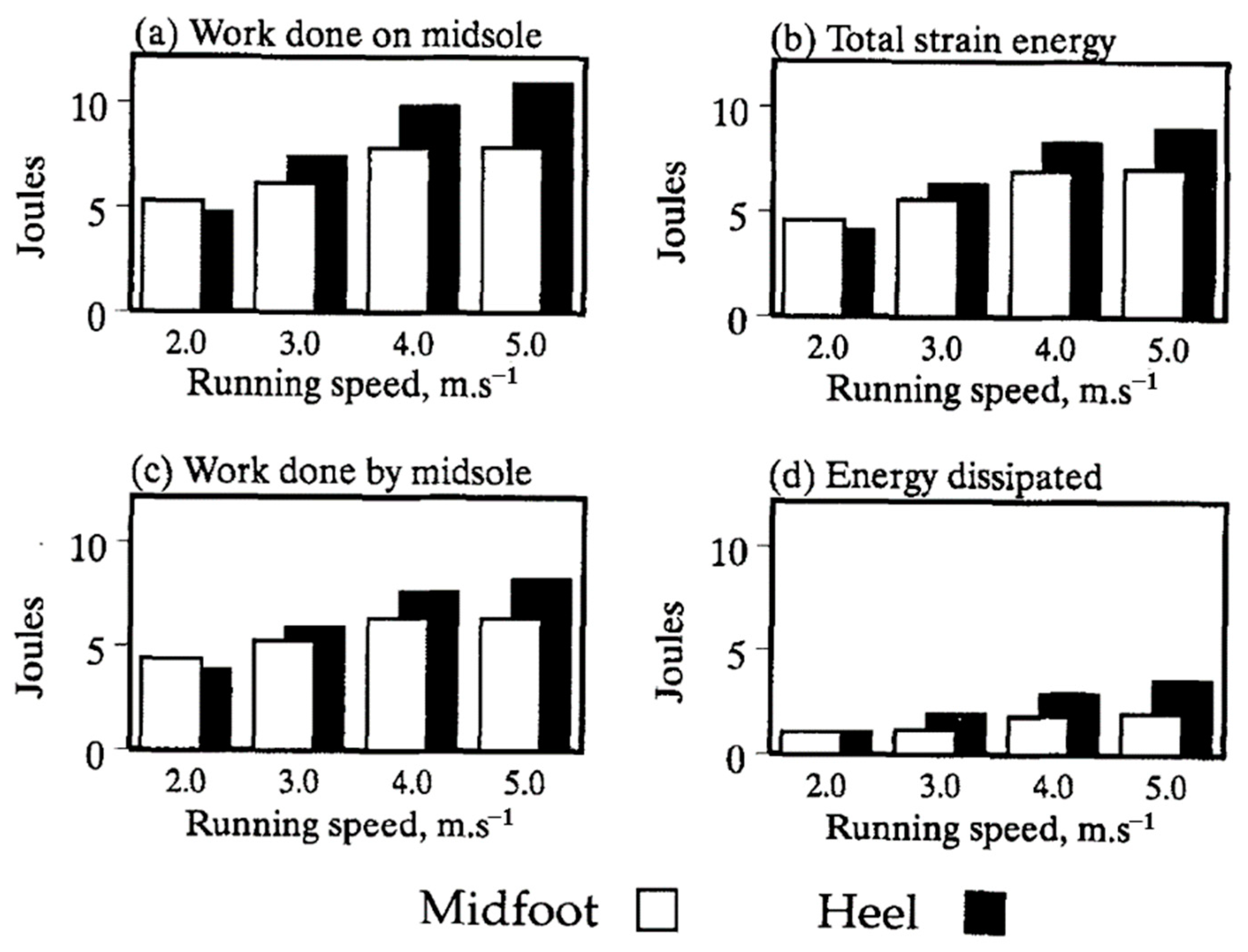

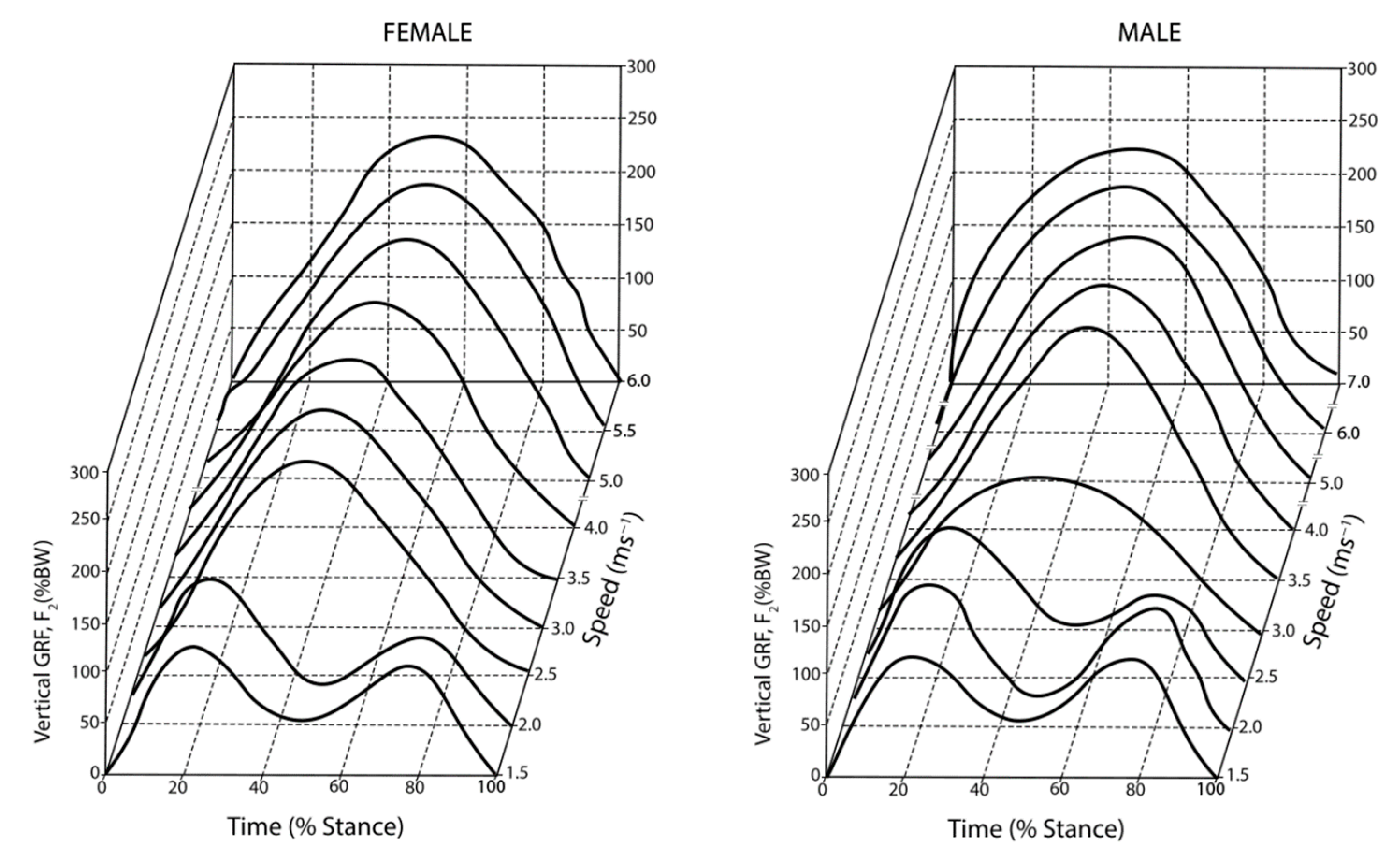

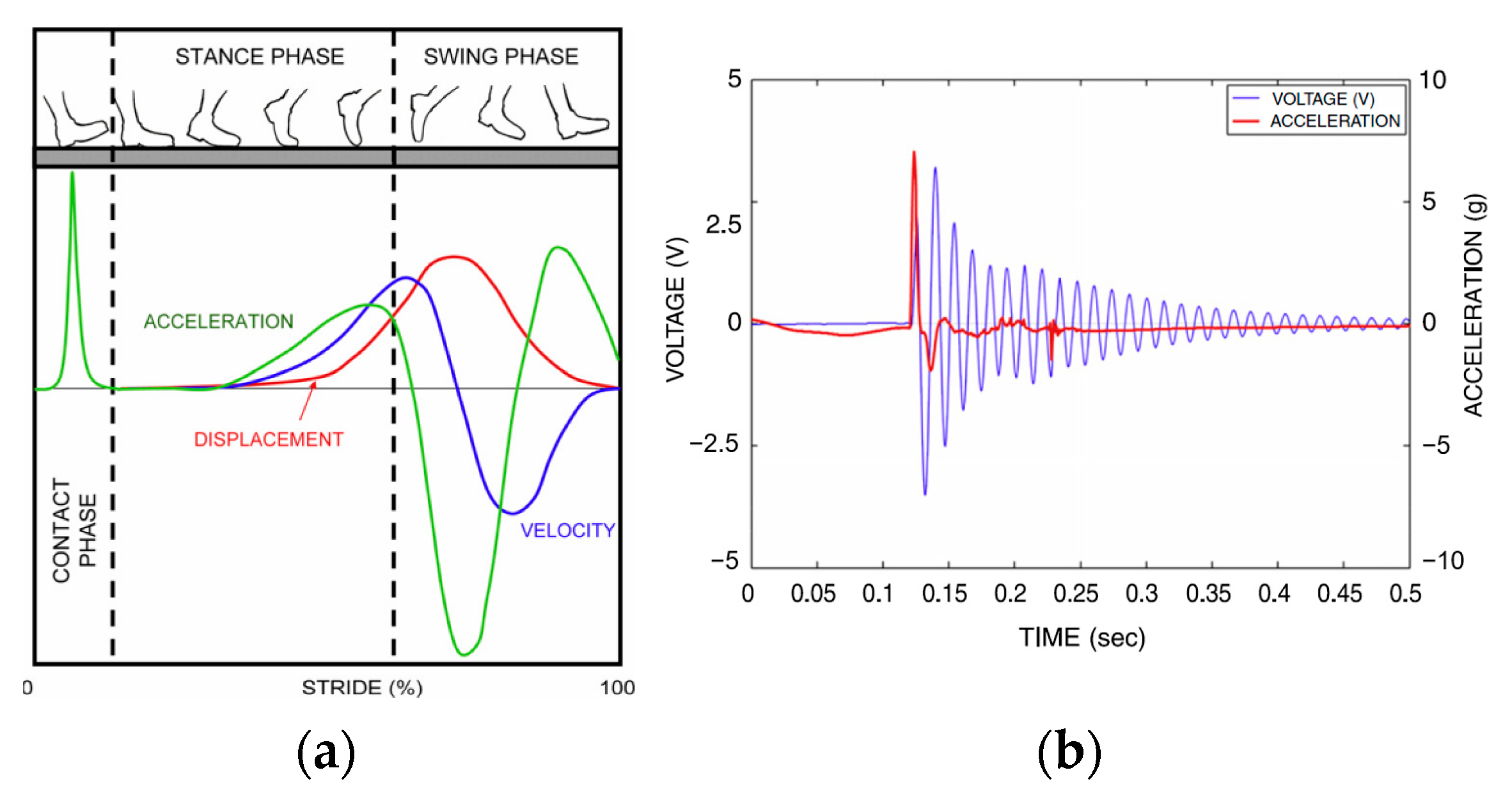
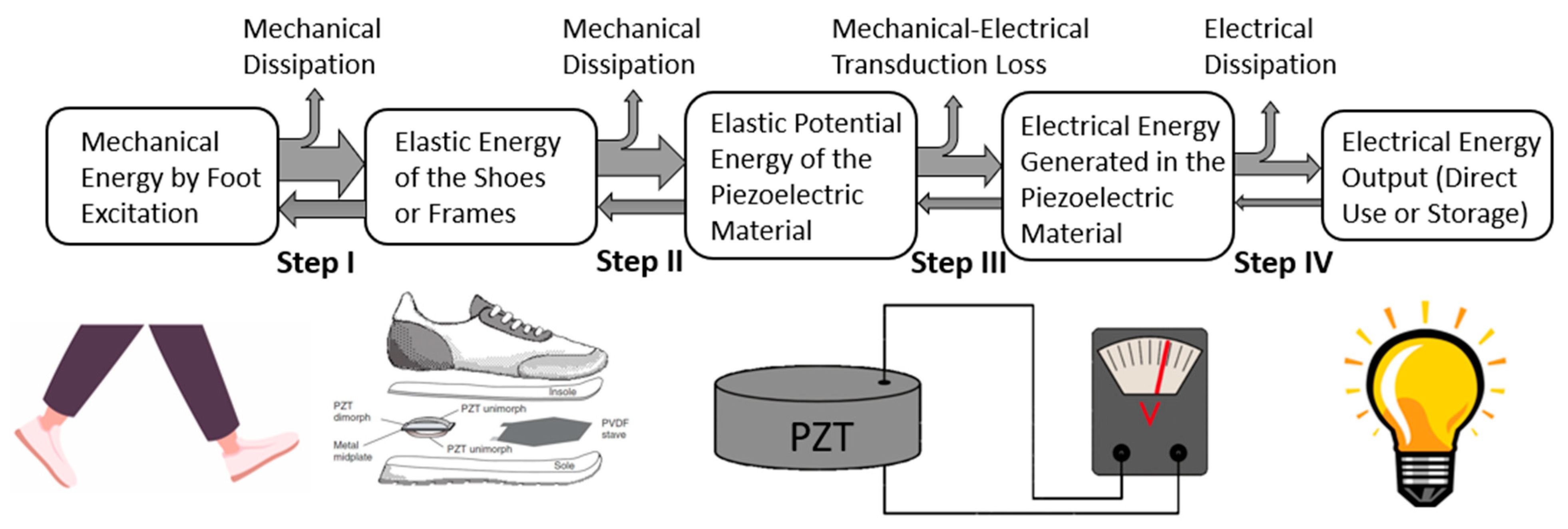







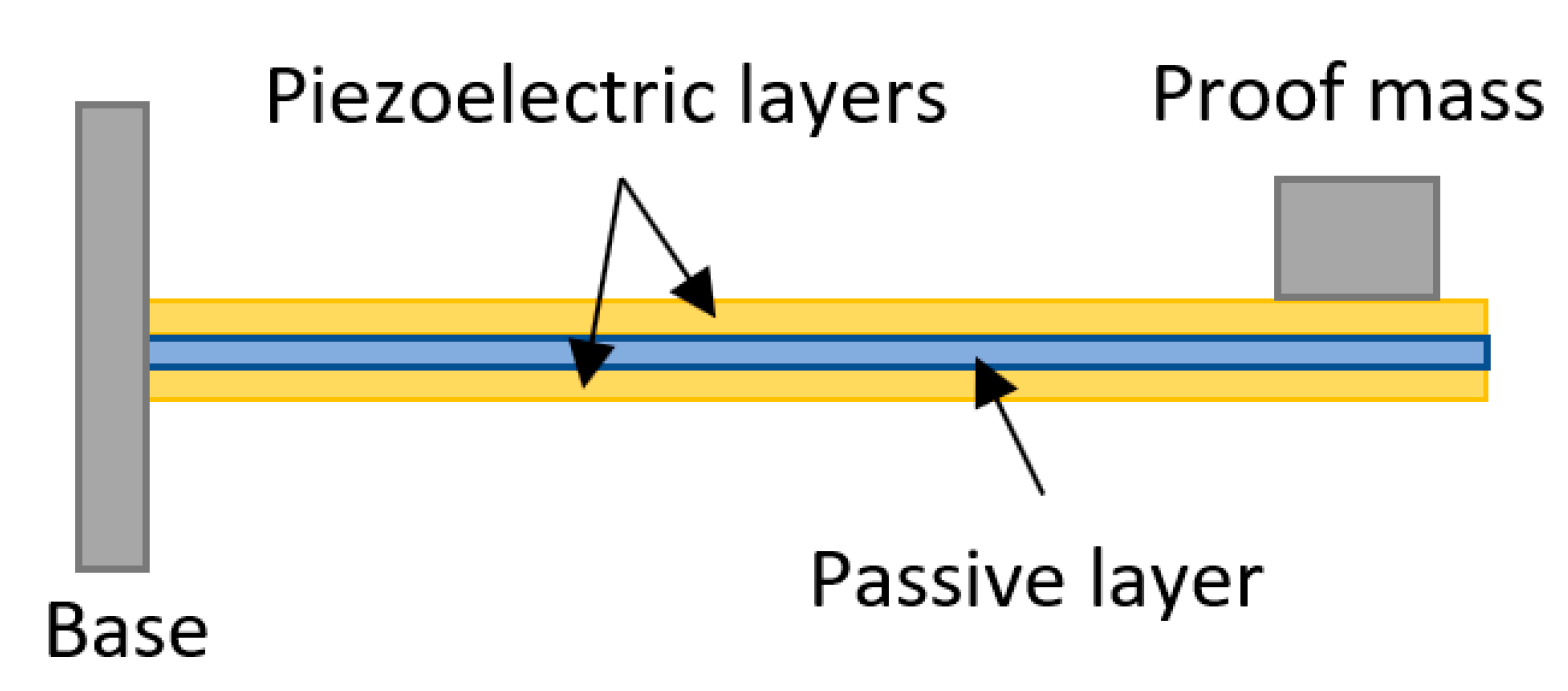




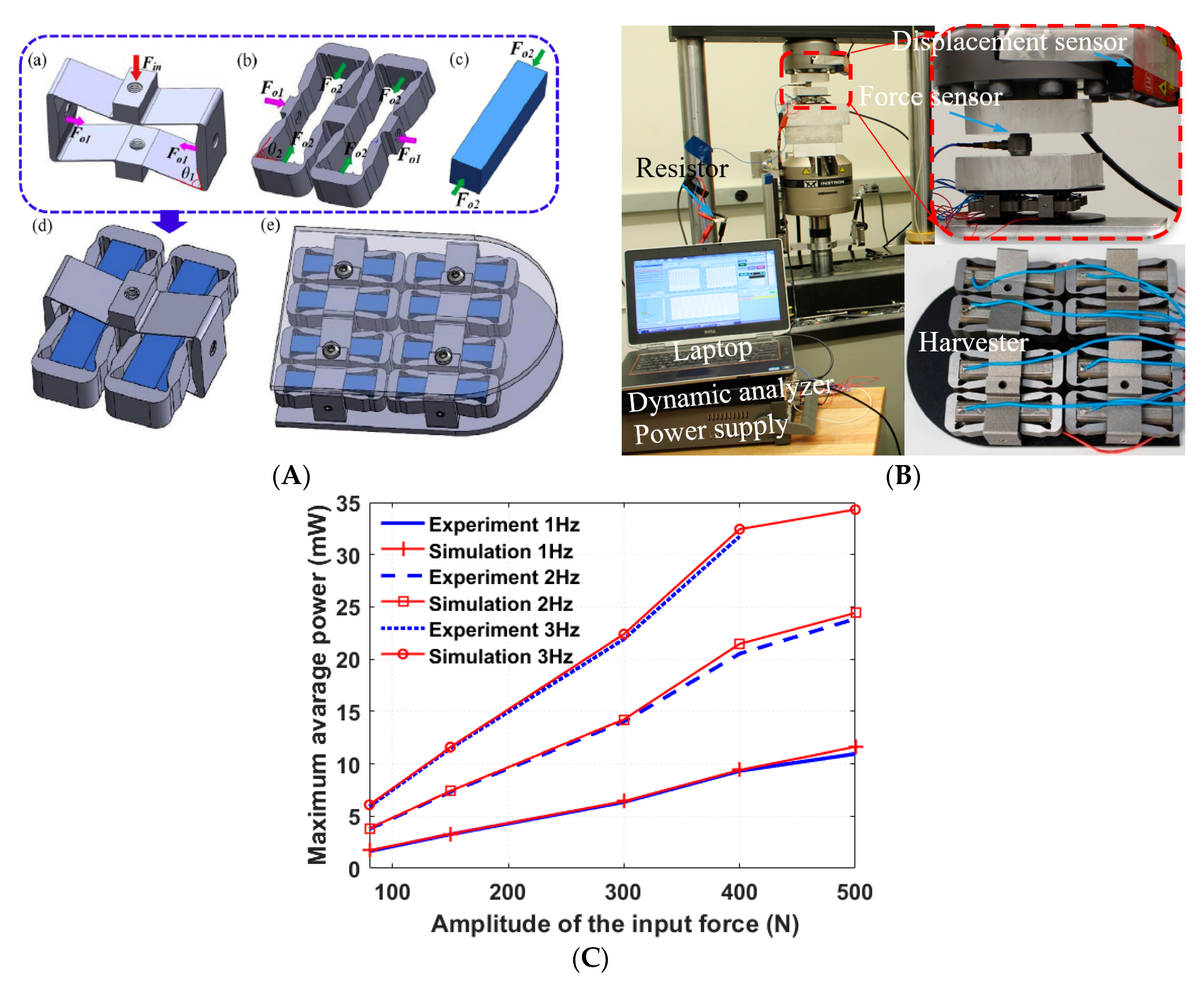
| Energy Harvesting Method | Advantages | Disadvantages |
|---|---|---|
| Piezoelectric |
|
|
| Electromagnetic |
|
|
| Triboelectric |
|
|
| Type | Description and Characteristics | Existing Solutions and Examples |
|---|---|---|
| Single-Crystal Materials |
|
|
| Lead-based Piezoceramics |
|
|
| Lead-free Piezoceramics |
|
|
| Piezopolymers |
|
|
| Material Properties | Symbol | ZnO | PMN-32%PT | PZT-4 | PZT-5A | PZT-5H | BaTiO3 | PVDF |
|---|---|---|---|---|---|---|---|---|
| Relative dielectric constant (1 kHz) | 8.67 | 1620 | 1475 | 1600 | 1436 | 13.5 | ||
| 11.26 | 7000 | 1300 | 1800 | 3800 | 1680 | |||
| Piezoelectric charge constant (10−12 C/N) | −5.12 | −760 | −123 | −190 | −320 | −79 | 25 | |
| 12.3 | 1620 | 289 | 390 | 650 | 191 | −23 | ||
| −8.3 | 192 | 496 | 460 | 1000 | 270 | |||
| Piezoelectric voltage constant (10−3 Vm/N) | −0.45 | −12.29 | −11.1 | −11.3 | −9.5 | −4.7 | 210 | |
| 1.09 | 26.15 | 26.1 | 23.2 | 19 | 11.4 | −330 | ||
| 13.39 | 39.4 | 32.4 | 35.5 | 18.8 | ||||
| Electromechanical coupling coefficients | 0.18 | 0.44 | 0.33 | 0.35 | 0.44 | 0.21 | 0.1 | |
| 0.47 | 0.93 | 0.7 | 0.72 | 0.75 | 0.49 | |||
| 0.23 | 0.62 | 0.58 | 0.49 | 0.55 | 0.12 | |||
| Energy conversion efficiency | 0.03 | 0.19 | 0.11 | 0.12 | 0.19 | 0.04 | 0.01 | |
| 0.22 | 0.86 | 0.49 | 0.52 | 0.56 | 0.24 | |||
| 0.05 | 0.38 | 0.34 | 0.24 | 0.30 | 0.01 | |||
| Mechanical quality factor | 69 | 500 | 80 | 32 | 300 | 3~10 | ||
| Dielectric loss | 0.42% | 0.4% | 0.02% | 2% | ||||
| Curie temperature (°C) | 554 | 145 | 328 | 350 | 225 | 115 | 100 | |
| Operation frequency | N/A | Up to GHz | Up to GHz | Up to GHz | Up to GHz | Up to GHz | Up to GHz | Up to MHz |
| Minimum size | N/A | Down to nm | Down to nm | Down to nm | Down to nm | Down to nm | Down to nm | Down to nm |
| Area | Martínez-Nova | Putti | Fernández-Seguín | Xu | Bryant |
|---|---|---|---|---|---|
| Heel | 253.1 ± 20.2 | 264.3 ± 44.1 | 270.13 ± 6.15 | 237.9 ± 50.1 | 167 ± 24 |
| Midfoot | 65.9 ± 16.8 | 109.0 ± 38.5 | 28.62 ± 1.48 | 65.3 ± 27.3 | 39 ± 25 |
| Met Head 1 | 308.2 ± 36.1 | 248.0 ± 70.1 | 55.56 ± 3.53 | 178.3 ± 38.3 | 122 ± 33 |
| Met Head 2 | 405.8 ± 57.4 | 246.5 ± 48.3 | 123.03 ± 4.86 | 367.5 ± 87.9 | 188 ± 41 |
| Met Head 3 | 394.1 ± 37.7 | 224.7 ± 50.4 | 157.44 ± 3.06 | 344.6 ± 101.4 | 154 ± 32 |
| Met Head 4 | 203.6 ± 22.5 | 161.0 ± 49.7 | 114.98 ± 3.22 | 234.6 ± 56.3 | 114 ± 39 |
| Met Head 5 | 118.4 ± 18.3 | 141.6 ± 58.4 | 52.89 ± 2.66 | 116.4 ± 31.2 | 89 ± 43 |
| Hallux | 146.5 ± 22.5 | 280.4 ± 83.0 | 100.14 ± 3.46 | 161.6 ± 48.9 | 139 ± 38 |
| Lesser Toes | 105.3 ± 14.3 | 130.3 ± 55.3 | 27.51 ± 2.41 | 47.1 ± 22.3 | 83 ± 25 |
| Structure | Reference | Material | Size (mm × mm × mm) | Average Power | Location |
|---|---|---|---|---|---|
| Flat plate | Kymissis J et al. [120] | PVDF | 100 × 80 × 2.45 | 1.0 mW@1 Hz | On the sole |
| Jeong SY et al. [17] | PZT | 60 × 40 × 7 | 0.8 mW@1 Hz | On the sole | |
| Ahmad N et al. [19] | PZT | Ø27, thick 0.6, total 5 discs | 1.41 mW@1 Hz | On insole | |
| Chaudhary P et al. [129] | PZT | A Ø50 disc | 0.2 mW@6 km/h | Inside sole | |
| Curved | Kymissis J et al. [120] | PZT | 70 × 70 × 7 | 2.0 mW@1 Hz | On the sole |
| J Zhao et al. [106] | PVDF | 80 × 50 × 0.24 | 1.0 mW@1 Hz | On the sole | |
| Jung WS et al. [105] | PVDF | 70 × 40 × 0.6 | 0.5 mW@0.5 Hz | Inside insole | |
| Cantilever | L Moro et al. [13] | PZT | 20 × 14 × 0.4 | 13.8 μW@1 Hz | Heel |
| Xin Y et al. [130] | PVDF | 495.8 μW | Heel | ||
| Fan et al. [137] | PZT | 19.1 × 7.1 × 0.245 | 0.35 mW@8 km/h | Heel | |
| Flextensional | Leinonen et al. [16] | PZT | Ø35, thick 2.7 | 0.8 mW@1 Hz | Heel |
| Y Kuang et al. [112] | PZT | 52 × 30 × 16.2 | 2.5 mW@4.8 km/h | Inside sole | |
| Qian F et al. [14] | PZT | 94 × 68 × 24 | 9.3 mW@4.8 km/h | Heel | |
| Qian F et al. [69] | PZT | 23.9 mW@2 Hz | Heel |
Disclaimer/Publisher’s Note: The statements, opinions and data contained in all publications are solely those of the individual author(s) and contributor(s) and not of MDPI and/or the editor(s). MDPI and/or the editor(s) disclaim responsibility for any injury to people or property resulting from any ideas, methods, instructions or products referred to in the content. |
© 2023 by the authors. Licensee MDPI, Basel, Switzerland. This article is an open access article distributed under the terms and conditions of the Creative Commons Attribution (CC BY) license (https://creativecommons.org/licenses/by/4.0/).
Share and Cite
Zhao, B.; Qian, F.; Hatfield, A.; Zuo, L.; Xu, T.-B. A Review of Piezoelectric Footwear Energy Harvesters: Principles, Methods, and Applications. Sensors 2023, 23, 5841. https://doi.org/10.3390/s23135841
Zhao B, Qian F, Hatfield A, Zuo L, Xu T-B. A Review of Piezoelectric Footwear Energy Harvesters: Principles, Methods, and Applications. Sensors. 2023; 23(13):5841. https://doi.org/10.3390/s23135841
Chicago/Turabian StyleZhao, Bingqi, Feng Qian, Alexander Hatfield, Lei Zuo, and Tian-Bing Xu. 2023. "A Review of Piezoelectric Footwear Energy Harvesters: Principles, Methods, and Applications" Sensors 23, no. 13: 5841. https://doi.org/10.3390/s23135841
APA StyleZhao, B., Qian, F., Hatfield, A., Zuo, L., & Xu, T.-B. (2023). A Review of Piezoelectric Footwear Energy Harvesters: Principles, Methods, and Applications. Sensors, 23(13), 5841. https://doi.org/10.3390/s23135841






